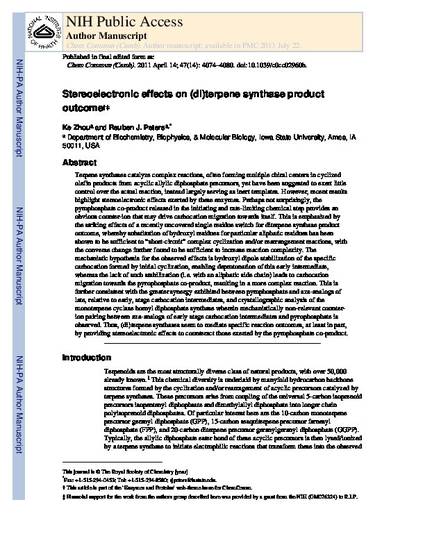
Terpene synthases catalyze complex reactions, often forming multiple chiral centers in cyclized olefin products from acyclic allylic diphosphate precursors, yet have been suggested to exert little control over the actual reaction, instead largely serving as inert templates. However, recent results highlight stereoelectronic effects exerted by these enzymes. Perhaps not surprisingly, the pyrophosphate co-product released in the initiating and rate-limiting chemical step provides an obvious counter-ion that may drive carbocation migration towards itself. This is emphasized by the striking effects of a recently uncovered single residue switch for diterpene synthase product outcome, whereby substitution of hydroxyl residues for particular aliphatic residues has been shown to be sufficient to “short-circuit” complex cyclization and/or rearrangement reactions, with the converse change further found to be sufficient to increase reaction complexity. The mechanistic hypothesis for the observed effects is hydroxyl dipole stabilization of the specific carbocation formed by initial cyclization, enabling deprotonation of this early intermediate, whereas the lack of such stabilization (i.e. with an aliphatic side chain) leads to carbocation migration towards the pyrophosphate co-product, resulting in a more complex reaction. This is further consistent with the greater synergy exhibited between pyrophosphate and aza-analogs of late, relative to early, stage carbocation intermediates, and crystallographic analysis of the monoterpene cyclase bornyl diphosphate synthase wherein mechanistically non-relevant counterion pairing between aza-analogs of early stage carbocation intermediates and pyrophosphate is observed. Thus, (di)terpene synthases seem to mediate specific reaction outcomes, at least in part, by providing stereoelectronic effects to counteract those exerted by the pyrophosphate co-product.
Available at: http://works.bepress.com/reuben_peters/48/

This is a manuscript of an article published as Zhou, Ke, and Reuben J. Peters. "Electrostatic effects on (di) terpene synthase product outcome." Chemical Communications 47, no. 14 (2011): 4074-4080. doi: 10.1039/C0CC02960B. Posted with permission.